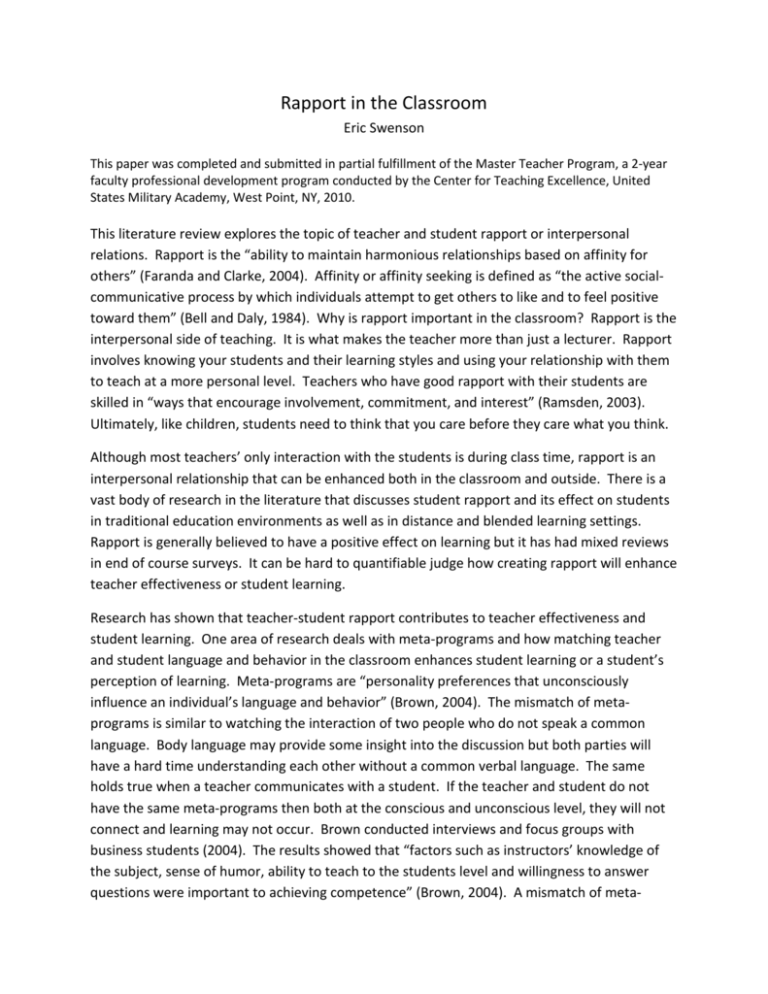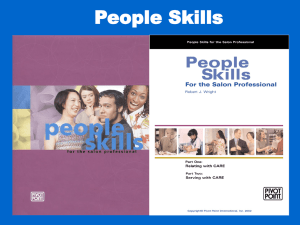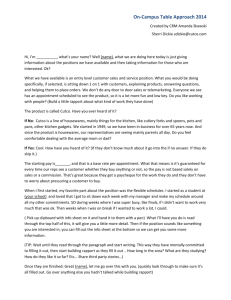Rapport in the Classroom: Teacher-Student Relationships
advertisement

Rapport in the Classroom Eric Swenson This paper was completed and submitted in partial fulfillment of the Master Teacher Program, a 2-year faculty professional development program conducted by the Center for Teaching Excellence, United States Military Academy, West Point, NY, 2010. This literature review explores the topic of teacher and student rapport or interpersonal relations. Rapport is the “ability to maintain harmonious relationships based on affinity for others” (Faranda and Clarke, 2004). Affinity or affinity seeking is defined as “the active socialcommunicative process by which individuals attempt to get others to like and to feel positive toward them” (Bell and Daly, 1984). Why is rapport important in the classroom? Rapport is the interpersonal side of teaching. It is what makes the teacher more than just a lecturer. Rapport involves knowing your students and their learning styles and using your relationship with them to teach at a more personal level. Teachers who have good rapport with their students are skilled in “ways that encourage involvement, commitment, and interest” (Ramsden, 2003). Ultimately, like children, students need to think that you care before they care what you think. Although most teachers’ only interaction with the students is during class time, rapport is an interpersonal relationship that can be enhanced both in the classroom and outside. There is a vast body of research in the literature that discusses student rapport and its effect on students in traditional education environments as well as in distance and blended learning settings. Rapport is generally believed to have a positive effect on learning but it has had mixed reviews in end of course surveys. It can be hard to quantifiable judge how creating rapport will enhance teacher effectiveness or student learning. Research has shown that teacher-student rapport contributes to teacher effectiveness and student learning. One area of research deals with meta-programs and how matching teacher and student language and behavior in the classroom enhances student learning or a student’s perception of learning. Meta-programs are “personality preferences that unconsciously influence an individual’s language and behavior” (Brown, 2004). The mismatch of metaprograms is similar to watching the interaction of two people who do not speak a common language. Body language may provide some insight into the discussion but both parties will have a hard time understanding each other without a common verbal language. The same holds true when a teacher communicates with a student. If the teacher and student do not have the same meta-programs then both at the conscious and unconscious level, they will not connect and learning may not occur. Brown conducted interviews and focus groups with business students (2004). The results showed that “factors such as instructors’ knowledge of the subject, sense of humor, ability to teach to the students level and willingness to answer questions were important to achieving competence” (Brown, 2004). A mismatch of meta- programs can result in poor perception of high quality teaching even when the teacher is competent (Brown, 2004). A similar line of research looked at rapport building in the day to day or moment to moment interaction between an instructor and a student. Building rapport with students is an important component to successful communication especially when the subject is learning a second language. Nguyen researched building student rapport in an ESOL (English for speakers of other languages) grammar class in which he studied competent teachers and their approach to building rapport in the classroom (2007). The teachers effectively switched among a variety of techniques depending on the verbal and nonverbal queues they were receiving from the students. The techniques included “lexical items, special grammatical structures, formulaic expressions, speech tempo and body language” (Nguyen, 2007). The study showed that instructors were building rapport throughout the lesson as they focused on building an interpersonal relationship with the students. Through the interpersonal interactions, the students were able to observe the instructors communicating in the new language and then respond back thus reaffirming their learning (Nguyen, 2007). Building rapport is not easy nor will it occur automatically after some period of time. In order to get to the point where an instructor can read a person’s verbal or non verbal queues and then act appropriately takes experience and a desire to build a relationship. Murphy and Valdez show that challenges of collaborative learning are overcome with the implementation of a resistance breaking process that is grounded in rapport building (2005). The article lays out three phases that start with the first few meetings in which a low level of rapport is established and gradually builds to a high level of rapport; eventually, students feel comfortable in the classroom and start to learn more unique traits and characteristics about their classmates and instructors (Murphy and Valdez, 2005). Rapport is also essential in distance learning classes where the instructor has limited to no face time with students and where most teaching occurs online. One of the critical components to successful distance learning programs is building strong and continually growing studentinstructor rapport (Sull, 2009). Sull encourages instructors to be creative in building rapport and to use all available on line means to include chat rooms and discussion boards to increase positive contact with students. In a study done by Jones, et al. students in blended learning courses versus pure web based courses had more frequent message exchanges with both other students and their instructors (2009). Additionally, in the blended learning environment where the course meets a few times in person and the remainder is taught over the web, there was a higher incidence of rapport elements in messages and the online dialog or collaboration started earlier (Jones, et al., 2009). This reinforces that building rapport early in a course is critical to encouraging learning especially in the distance learning environment. In teaching effectiveness studies, good rapport and the ability to establish rapport with students is cited as an important factor in student learning. In one such study, 220 secondary school principals were asked what the leading causes were of teacher ineffectiveness. The top three causes were classroom management skills, lesson implementation skills, and rapport with students (Torff and Sessions, 2005). Content knowledge deficiencies were ranked lower, indicating that a teacher’s knowledge of the subject matter was less of a cause of teacher inefficiencies than the ability to build rapport. In support of this, Teven and McCroskey found significant evidence to support their hypothesis that “students who perceive their instructors as more caring will report they have learned more in the course” (1996). Once again, the caring element is a byproduct of the interpersonal relationship between the teacher and the student. In much of the research about rapport in the classroom, there is a positive link between having solid instructor-student rapport and effective teaching. However, one of the main ways that colleges measure teacher effectiveness is through student evaluations which may not be an accurate assessment (Delucchi, 2000; Delucchi and Pelowski, 2000). Tenure and promotion are two very important topics for college professors especially when some colleges use student feedback to help determine one or both of them. Teachers looking to advance in the ranks may use rapport building to build solid student evaluations at the expense of a rigorous course (Delucchi, 2000). Delucchi found that student perceived learning actually decreased with every one percent increase in the amount that students like their instructor (2000). Whereas, in the same study, an increase in likeability of the instructor resulted in an overall increase in the students perception of their instructor’s teaching ability (Delucchi, 2000). Kozub found that rapport is positively correlated to overall student ratings of teacher effectiveness (2010). Lowman indicates that student ratings reflect the quality or level of rapport between students and their instructor (1995). Additionally, effective college teachers can create intellectual excitement while also build rapport with their students; success in one area alone will ensure effective teaching to at least some of the students (Lowman, 1995). Although most of the rapport research is student centered, faculty has something to gain from a positive rapport with their students. Granitz, et al. built a model for rapport which included three antecedents (approach, personality, and homophily) and four outcomes (student benefits, faculty benefits, benefits outside the classroom, and faculty-student benefits) (2008). There research was based on perceptions from business faculty in a variety of private and public schools. Their results indicated that increased rapport can have faculty benefits that include personal enjoyment and satisfaction in teaching, increased appreciation as a teacher, higher teaching evaluations, and an increased reputation within the school (Granitz, et al., 2008). On the flip side, rapport has been shown to have a statistically significant positive effect on a student’s attitude toward the teacher and toward the course material when the instructor established rapport with the student (Benson and Cohen, 2005). In conclusion, the use of rapport in the classroom has been widely researched and discussed among teaching professionals. Although the effects of rapport building and their impact on student ratings of classroom learning are mixed, most of the research on rapport correlates to a positive impact on both students and instructors. Building rapport in the distance learning environment has had a profound effect on student learning; in these environments instructors must work harder to build rapport because of the lack of face to face time with their students. Rapport has also had a big impact on teaching second languages where interpersonal relationships help break down the barriers to learning. Teaching is as much about the technical merits of the instructor as it is about relationships in the classroom; successful teachers have learned how to build rapport with their students while challenging them to learn new material. References Bell, R. A. and Daly, J.A.(1984). The affinity seeking function of communication. Communication Monographs, 51, 91-115. Benson, T. and Cohen, A. (2005). Rapport: its relation to student attitudes and behaviors toward teachers and classes. Faculty Forum, 32(4), 237-239. Brown, Nigel (2004). What makes a good educator? The relevance of meta-programmes. Assessment and Evaluation in Higher Education, 29(5), 515-533. Delucchi, M. (2000). Don’t worry, be happy: instructor likeability, student perceptions of learning, and teacher ratings in upper level sociology courses. Teaching Sociology, 28, 220-231. Delucchi, M. and Pelowski, S. (2000). Liking or learning? The effect of instructor likeability and student perceptions of learning on overall rating of teaching ability. Radical Pedagogy, 2(2). (retrieved from the internet 21 April 2010). Faranda, W.T and Clarke I. (2004). Student observations of outstanding teaching: Implications for marketing educators. Journal of Marketing Education, 26(3), 271-281. Fleming, N. (2003). Establishing rapport: personal interaction and learning. The IDEA Center. Idea Paper 39. Granitz, N., Koernig, S. and Harich, K. (2009). Now it’s personal: antecedents and outcomes of rapport between business faculty and their students. Journal of Marketing Education, 31(1), 5265. Nguyen, H. (2007). Rapport building in language instruction: a microanalysis of the multiple resources in teacher talk. Language and Education, 21(4), 284-303. Jones, J., Warren, S., and Robertson, M. (2009). Increasing student discourse to support rapport building in web and blended courses using a 3D online learning environment. Journal of Interactive Learning Research, 20(3), 269-294. Kozub, R. (2010). Relationship of course, instructor, and student characteristics to dimensions of student ratings of teaching effectiveness in business schools. American Journal of Business Education, 3(1), 33-40. Lowman, Joseph (1995). Mastering the Techniques of Teaching, 2nd ed. San Francisco: JosseyBass. Murphy, M, and Valdez,C. (2005). Ravaging Resistance: a model for building rapport in a collaborative learning classroom [Electronic Version], Radical Pedagogy, 7.1.1 (retrieved from the internet 21 April 2010). Ramsden P. (2003). Learning to Teach in Higher Education (2nd ed.) London: Routledge and Falmer. Sull, E. (2009). Student engagement, motivation, and rapport. Distance Learning, 6(3), 90-94. Teven, J. and McCroskey, J. (1996). The relationship of perceived teacher caring with student learning and teaching evaluation. Communication Education, 46, 1-9. Torff, B. and Sessions, D. (2005). Principals’ perceptions of the causes of teacher Ineffectiveness. Journal of Educational Psychology, 97(4), 530-537. Annotated readings: Gorham, J., Kelley, D., and McCroskey, J. (1989). The affinity seeking of classroom teachers: A second perspective. Communication Quarterly, 37(1), 16-26. Study looks at 229 elementary and secondary school teachers and what they did to get students to like them and the subject matter they teach. Teachers were asked among other questions, to list five recent examples of things they did to get their students to like them and the course they teach. The results indicated the teachers used different methods to get students to like them verse the course they teach. Also, teachers have a harder time getting students to like the subject or course than they do to like themselves. This research is tied to work of McCroskey and McCroskey (1986) as well as Bell and Daly (1984). Meyers, S. (2009). Do your students care whether you care about them? College Teaching, 57(4), 205-210. Meyer’s analyses the “caring factor or caring dimension” in teaching and discusses how important it is in the student-teacher education model. Although students can tell when a teacher truly cares about their learning, Meyers argues that some instructors often do not prioritize the caring factor in their classroom. He agrees that students and professors are traditionally at odds when defining effective teaching and goes on to list many of the reasons that some college professors do not want to spend the effort to build rapport with their students. Meyers offers a host of tips on how to build both verbal and nonverbal immediacy in the classroom and how to do it when conditions are not ideal such as when class size is large or courses are web based. Meyer’s draws in the results of many other researchers to help make his points. McLaughlin, M. and Erickson, K. (1981). A multidimensional scaling analysis of the “ideal interpersonal communication instructor”. Communication Education, 30, 393-398. The study looked at “the ideal interpersonal communications teacher and the relative contributions of learner perceived teacher behaviors” from the students’ perspective. The results from a Texas Tech study of 204 students and five fully qualified professors showed that student perceptions are tied to student morale and efficiency, and students judge their professors based on an “ideal instructor”. Student perceptions of an instructor’s style might be misinterpreted based on the student expectations. Frymier, A. and Houser, M. (2000). The teacher-student relationship as an interpersonal relationship. Communications Education, 49(3) 207-219. Frymier and Houser investigated student-teacher relationships from the student’s perspective. Specifically, the “students’ perception of the importance of communication skills to effective teaching” and “students’ perceptions of the use of communication skills by specific teachers and their relationship to students’ learning”. The results of their study show that the two dimensions of teaching, content and relational, are both essential in the classroom. Teachers who can see their students as individuals will build interpersonal relationships that will enable the students to attain a higher level of learning. Gender differences were also considered in this work to assess if male or female perceptions were statistically different. Baringer, D. and McCroskey, J. (2000). Immediacy in the classroom: student immediacy. Communication Education, 49(2), 178-186. The research focused on non-verbal immediacy and its effect on the teacher. This study supports the work Rosoff did in 1978 when he studied the effects of positive feedback on teacher perceptions of students. Baringer and McCroskey surveyed 129 instructors from 35 disciplines in which they asked the instructor to keep a randomly selected current student in mind when answering the questions. Immediacy, credibility, interpersonal attraction, and achievement were measured. The results indicate that students are generally perceived more positively when they are perceived as immediate (have immediacy with the instructor). Likewise, teachers are more motivated to teach students who they feel are more immediate with them. When teacher have rapport with their students and the students are more immediate with the instructors, student learning is enhanced. Goldstein, G. and Benassi, V. (1994). The relation between teacher self-disclosure and student classroom participation. Teaching of Psychology, 21(4), 212-217. Goldstein and Benassi surveyed students and faculty to identify if there is a correlation between the amount of self- disclosure that a teacher uses in class and student participation in class. The investigation surveyed both students and teachers in 64 undergraduate classes covering 30 disciplines. Although, others had looked at teacher self-disclosure, none had compared teacher self-disclosure to student participation or student reciprocity. There are many ways to build rapport in the classroom, and as this study showed, using self-disclosure to encourage students to interact with the instructor or feel more at ease has shown to be helpful.




